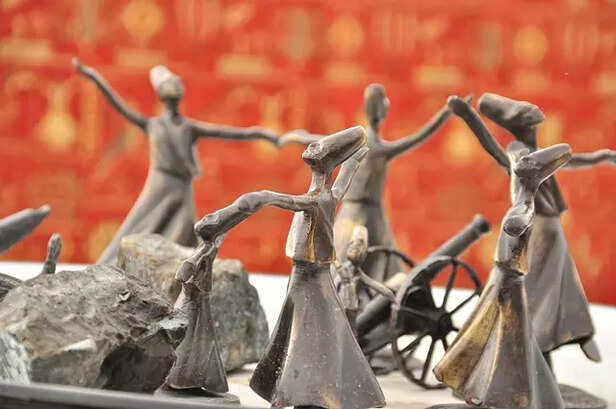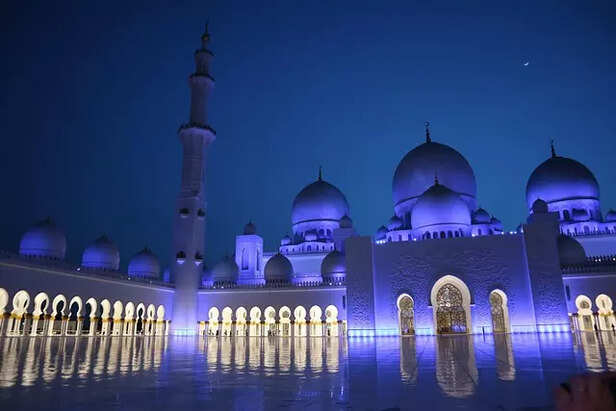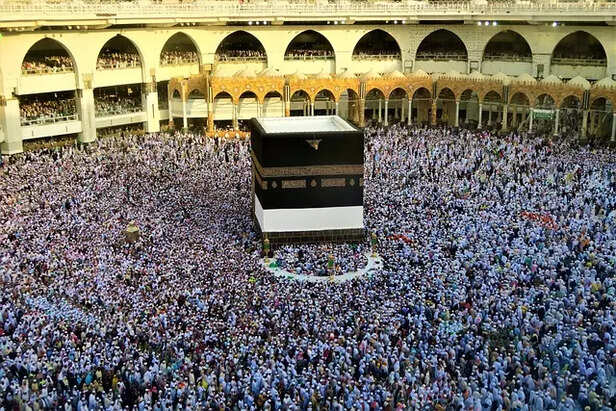Sufi Saints & Vasant Panchami: The Untold Islamic Connection That Will Shock You!
Tarun Badghaiya | Feb 03, 2025, 02:02 IST
The intersection of Sufism and Indian traditions has resulted in some of the most spiritually fulfilling and culturally significant festivities. One such fascinating junction is the connection between Sufi saints and the Vasant Panchami festival, which marks the start of spring in India. Although Vasant Panchami is predominantly a Hindu festival honouring Goddess Saraswati, the personification of wisdom and learning, it was also celebrated by Sufi saints, notably in North India. Their participation in the celebration was more than just following local customs; it was a powerfully symbolic act that spoke to the mystical and universal character of Sufism.
The intersection of Sufism and Indian traditions has resulted in some of the most spiritually fulfilling and culturally significant festivities. One such fascinating junction is the connection between Sufi saints and the Vasant Panchami festival, which marks the start of spring in India. Although Vasant Panchami is predominantly a Hindu festival honouring Goddess Saraswati, the personification of wisdom and learning, it was also celebrated by Sufi saints, notably in North India. Their participation in the celebration was more than just following local customs; it was a powerfully symbolic act that spoke to the mystical and universal character of Sufism.

Sufism, a mystical offshoot of Islam, is recognised for its inclusiveness, love of people, and belief in God's presence in all things. Unlike traditional theological theories, Sufism emphasises direct communication with the divine through love, music, and poetry. When Sufi saints arrived in India, they found a land rich in spiritual diversity. Rather than opposing local customs, they welcomed them and used them to preach their universal message of love, harmony, and heavenly devotion.
One of the most deep examples of cultural fusion is Hazrat Nizamuddin Auliya's adoption of Vasant Panchami, one of the most venerated Sufi saints of the Chishti order in New Delhi. His affiliation with this festival is legendary, and it continues to be part of Sufi celebrations.
Hazrat Nizamuddin Auliya (1238–1325), a renowned Sufi saint, lived in Delhi in the 13th and 14th centuries. His teachings centred on divine love, humility, and service to humanity. The story of his relationship with Vasant Panchami is inextricably related to that of his dedicated follower and famed poet Amir Khusrau.
Nizamuddin Auliya is claimed to have been terribly saddened during a time of great mourning following the loss of his beloved nephew. His disciples were concerned about his state of mind. One day, Amir Khusrau saw a group of Hindu women dressed in bright yellow, happily celebrating Basant Panchami with singing and flowers. Seeing their delight, he was moved to impart this tradition to his spiritual master as a way to brighten his mood.
Khusrau, noted for his humour and musical talent, dressed in yellow and went to Nizamuddin's khanqah (spiritual residence) to sing songs about spring and renewal. Nizamuddin Auliya was deeply moved by the gesture and smiled after a long period of grieving. This moment marked the start of an annual Basant celebration at his shrine, during which disciples and devotees wore yellow and sung spiritual songs in honour of the saint and the holy.

For the Sufis, Basant was more than just a seasonal celebration; it represented spiritual rejuvenation and heavenly love. The festival's prominent colour, yellow, symbolises light, enlightenment, and surrender to the divine will. Basant, like spring, represents rebirth in nature, and Sufis considered it an opportunity for spiritual enlightenment and rejuvenation.
In Sufi philosophy, the metaphor of spring is frequently employed to symbolise a seeker's spiritual path. Just as winter gives way to flower blooming, a seeker who goes through difficulties and tribulations eventually achieves heavenly understanding. Basant celebrations became a metaphor for Sufis' joy, devotion, and heavenly love.
The tradition initiated by Hazrat Nizamuddin Auliya continues to this day at several prominent Sufi shrines (dargahs) in India and Pakistan.
1. Hazrat Nizamuddin Dargah, Delhi.
Every year on Basant Panchami, people assemble at Hazrat Nizamuddin Auliya's Dargah in Delhi. The shrine is decorated with yellow flowers, and qawwals (Sufi musicians) perform special Basant-themed qawwalis. Devotees dress in yellow and bring chadar (a sacred cloth) to the saint's tomb. The air is alive with spiritual poetry and Sufi music, inspiring a profound sense of connection with the holy.
2. Dargah of Khwaja Moinuddin Chishti in Ajmer.
Another important site for Basant celebrations is the Ajmer Sharif Dargah, which is the final resting place of Khwaja Moinuddin Chishti, the founder of the Chishti Sufi order in India. Although not as spectacular as the celebrations in Delhi, the event is marked by the recitation of mystical poetry and prayers.
3. Other Sufi shrines in India and Pakistan.
Basant celebrations take place at Sufi shrines throughout the Indian subcontinent, including Pakpattan (Pakistan) and Nagpur (India), with devotees participating in music, poetry, and prayers.

The relationship between Basant Panchami and Sufi Qawwali is noteworthy. Qawwali, a type of devotional music with its roots in Sufism, evolved into a means of expressing spiritual longing and love. Amir Khusrau, considered the father of qawwali, wrote several verses about spring, love, and divine favour. His Basant-inspired works continue to be performed at Sufi meetings, reaffirming the mystical link between nature's rebirth and spiritual enlightenment.
Sufi saints' participation in Basant Panchami festivals exemplifies the attitude of cultural inclusion and syncretism that characterised Indian Sufism. It represented the concept that the sacred might be celebrated in a variety of ways that cut across religious bounds. Sufis' participation acknowledged the occasion while also sending a message of communal harmony, coexistence, and love for all.
Even today, in a world divided by religion, the legacy of these celebrations serves as a reminder of India's rich, eclectic traditions. The Basant holiday at Sufi shrines continues to attract individuals of all religions, reaffirming the concept that spirituality is a universal human experience that transcends denominational boundaries.

The mystical connection between Sufi saints and Vasant Panchami is a testament to the deep-rooted interfaith harmony that has flourished in India for centuries. What began as a gesture to cheer a grieving saint evolved into a spiritual tradition that blended Hindu and Sufi customs. The celebration of Basant at Sufi shrines symbolises the universal message of love, renewal, and divine joy—a message that remains relevant today.
By embracing indigenous traditions such as Basant Panchami, the Sufis not only bridged theological divides but also enriched the Indian subcontinent's cultural and spiritual landscape. Their legacy continues to inspire millions, demonstrating that true mysticism transcends frontiers and unifies people in their search for divine love.

sufism
1. Sufism and the Embrace of Local Traditions:
One of the most deep examples of cultural fusion is Hazrat Nizamuddin Auliya's adoption of Vasant Panchami, one of the most venerated Sufi saints of the Chishti order in New Delhi. His affiliation with this festival is legendary, and it continues to be part of Sufi celebrations.
2. The Legend of Hazrat Nizamuddin Auliya and Basant:
Nizamuddin Auliya is claimed to have been terribly saddened during a time of great mourning following the loss of his beloved nephew. His disciples were concerned about his state of mind. One day, Amir Khusrau saw a group of Hindu women dressed in bright yellow, happily celebrating Basant Panchami with singing and flowers. Seeing their delight, he was moved to impart this tradition to his spiritual master as a way to brighten his mood.
Khusrau, noted for his humour and musical talent, dressed in yellow and went to Nizamuddin's khanqah (spiritual residence) to sing songs about spring and renewal. Nizamuddin Auliya was deeply moved by the gesture and smiled after a long period of grieving. This moment marked the start of an annual Basant celebration at his shrine, during which disciples and devotees wore yellow and sung spiritual songs in honour of the saint and the holy.

mosque
3. Symbolism of Basant Panchami in Sufism:
In Sufi philosophy, the metaphor of spring is frequently employed to symbolise a seeker's spiritual path. Just as winter gives way to flower blooming, a seeker who goes through difficulties and tribulations eventually achieves heavenly understanding. Basant celebrations became a metaphor for Sufis' joy, devotion, and heavenly love.
4. Basant Celebrations at Sufi Shrines:
1. Hazrat Nizamuddin Dargah, Delhi.
Every year on Basant Panchami, people assemble at Hazrat Nizamuddin Auliya's Dargah in Delhi. The shrine is decorated with yellow flowers, and qawwals (Sufi musicians) perform special Basant-themed qawwalis. Devotees dress in yellow and bring chadar (a sacred cloth) to the saint's tomb. The air is alive with spiritual poetry and Sufi music, inspiring a profound sense of connection with the holy.
2. Dargah of Khwaja Moinuddin Chishti in Ajmer.
Another important site for Basant celebrations is the Ajmer Sharif Dargah, which is the final resting place of Khwaja Moinuddin Chishti, the founder of the Chishti Sufi order in India. Although not as spectacular as the celebrations in Delhi, the event is marked by the recitation of mystical poetry and prayers.
3. Other Sufi shrines in India and Pakistan.
Basant celebrations take place at Sufi shrines throughout the Indian subcontinent, including Pakpattan (Pakistan) and Nagpur (India), with devotees participating in music, poetry, and prayers.

mecca
5. Basant Panchami and Qawwali Tradition:
6. The Broader Cultural Significance:
Even today, in a world divided by religion, the legacy of these celebrations serves as a reminder of India's rich, eclectic traditions. The Basant holiday at Sufi shrines continues to attract individuals of all religions, reaffirming the concept that spirituality is a universal human experience that transcends denominational boundaries.

Sama in islam
The mystical connection between Sufi saints and Vasant Panchami is a testament to the deep-rooted interfaith harmony that has flourished in India for centuries. What began as a gesture to cheer a grieving saint evolved into a spiritual tradition that blended Hindu and Sufi customs. The celebration of Basant at Sufi shrines symbolises the universal message of love, renewal, and divine joy—a message that remains relevant today.
By embracing indigenous traditions such as Basant Panchami, the Sufis not only bridged theological divides but also enriched the Indian subcontinent's cultural and spiritual landscape. Their legacy continues to inspire millions, demonstrating that true mysticism transcends frontiers and unifies people in their search for divine love.
